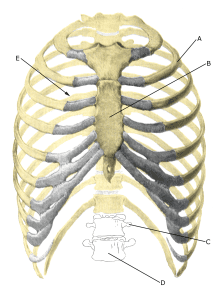Anatomy

The chest cavity with lungs and heart is protected by 12 sets of ribs that attach to the thoracic vertebrae at the back and the sternum at the front. Attached to the ribs are muscles that, among other things, help with breathing.
Chest
A. Ribs
B. Chest
C. Vertebra lumbalis (processus costalis)
D. L II (2nd lumbar vertebra)
Cause
A single forceful blow/fall can cause a fracture of the ribs, while repeated heavy loads (e.g. golf, rowing, tennis, swimming, gymnastics) can trigger a fatigue fracture (stress fracture).
Fatigue fractures are most commonly seen in the 1st rib, especially in basketball players, weightlifters and ballet dancers. Fatigue fractures in the 4th-9th ribs are seen in competitive rowers, and posteromedial fatigue fractures are seen in golfers.
Symptoms
Pain on pressure (direct and indirect tenderness), deep breathing and coughing.
Examination
Diagnosis is usually made by general medical examination. The fracture is best seen on ultrasoundscanning, but it is often missed on X-ray (Griffith JF, et al. 1999).
Treatment
Treatment primarily involves relief. Paracetamol, possibly in combination with weak weak opioids can be used as an analgesic.
Rehabilitation
Rehabilitation can begin as soon as pain permits. You should expect it to take a few months before the rib has healed enough to resume contact sports.
Tape
Elastic bandages have little pain-relieving effect on rib fractures.
Complications
If the progression is not smooth, you should be examined by an appropriate professional to ensure the diagnosis is correct. If there is a sudden increase in breathlessness, the pointed end of the rib fracture may have punctured the lung. If this is suspected, seek emergency medical attention for examination and possible treatment.
